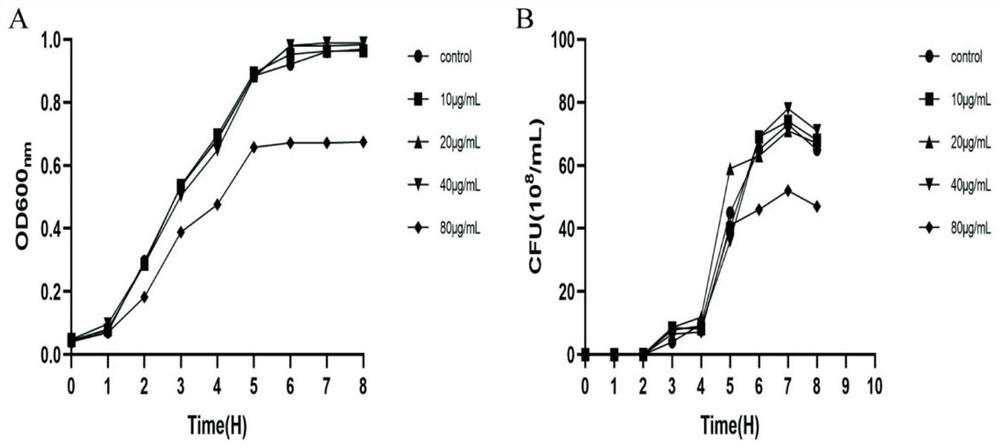Inhibitor for urinary tract infection pathogen urinary tract pathogenic escherichia coli
A technology for Escherichia coli and urinary tract infection, which is applied in the field of biomedicine and can solve the problems of easy recurrence and prolonged treatment period of urinary tract infection
- Summary
- Abstract
- Description
- Claims
- Application Information
AI Technical Summary
Problems solved by technology
Method used
Image
Examples
Embodiment 1
[0032] Example 1, Cyclotoxicity of Cyclotron to Bladder Epithelial Cell T24 (purchased from ATCC)
[0033] Take a 96-well plate, inoculate the incubated T24 cells into the 96-well plate, 100 μL per well, and inoculate 5000 cells per well. Add 100 μL of PBS to the wells around the edge of the 96-well plate to prevent evaporation, and continue to store in 5% CO 2 Incubate overnight in an incubator until it adheres to the wall. The 96-well plate was divided into 3 groups, which were blank group (only cell culture medium, no cells), control group (cells, no drug addition) and drug-dosed group (cells, different concentrations of leuconine were added). solution, doubling dilution so that the final concentrations of cisternaline were 200, 100, 50, 25, 12.5, 6.25, 3.125, 1.5625, 0 μg / mL). Each group has 6 parallel repetitions, continue to place the 96-well plate in 5%, CO 2 Incubate for 24 hours in the incubator. Add 10 μL of CCK-8 solution to each well and place in the incubator ...
Embodiment 2
[0036] Embodiment 2, the inhibitory ability of whitewash alkali to urinary tract pathogenic Escherichia coli
[0037] Take 15 15mL glass test tubes and divide them into 3 groups, 5 in each group. Prepare 4 concentrations of 10, 20, 40, and 80 μg / mL of bucristine, each with a total amount of 15 mL, and add them to the test tubes in order. Add 5 mL to each test tube, and add 5 mL to the last test tube. LB medium. In this way, the concentrations of Bazheng San in each group of 5 test tubes were 0, 10, 20, 40, 80 μg / mL, 3 groups in total. Add 50 μL of overnight cultured UPEC307 to each test tube, put it into the incubator to continue shaking culture at 37°C and 180r / min, take out a group every 1 hour to measure OD600nm value, and perform plate counting. Three groups were taken out alternately, and the OD values of each time period were recorded. After data sorting, the growth curve of UPEC307 under the action of different concentrations of whitewash was drawn.
[0038] The r...
Embodiment 3
[0039] Example 3, Inhibitory Effects of Blectronine on the Adhesion and Invasion Ability of UPEC307
[0040]The cultured T24 cells were digested with trypsin, resuspended in medium without double antibody, and counted. The counted cells were seeded in a 24-well plate, 2.5×10 per well 5 / mL cells, incubated at 37°C for 24 hours, removed the supernatant, and washed with pre-warmed PBS. The groups were divided into different concentrations of bucristine groups and a negative control group, with 3 replicate wells in each group. Pretreated with different concentrations of whitewash (2.5, 5, 10, 20 μg / mL) lower than cytotoxicity for 2 hours, UPEC307 was cultured to the logarithmic phase, and the number of bacteria was 1×10 8 CFU / mL, remove the supernatant after centrifugation, add serum-free DMEM cell culture medium to resuspend the bacteria at a multiplicity of infection of 100:1, then add the bacterial solution to a 24-well plate, and continue to incubate at 37°C for 2 hours. O...
PUM
 Login to View More
Login to View More Abstract
Description
Claims
Application Information
 Login to View More
Login to View More - R&D Engineer
- R&D Manager
- IP Professional
- Industry Leading Data Capabilities
- Powerful AI technology
- Patent DNA Extraction
Browse by: Latest US Patents, China's latest patents, Technical Efficacy Thesaurus, Application Domain, Technology Topic, Popular Technical Reports.
© 2024 PatSnap. All rights reserved.Legal|Privacy policy|Modern Slavery Act Transparency Statement|Sitemap|About US| Contact US: help@patsnap.com










